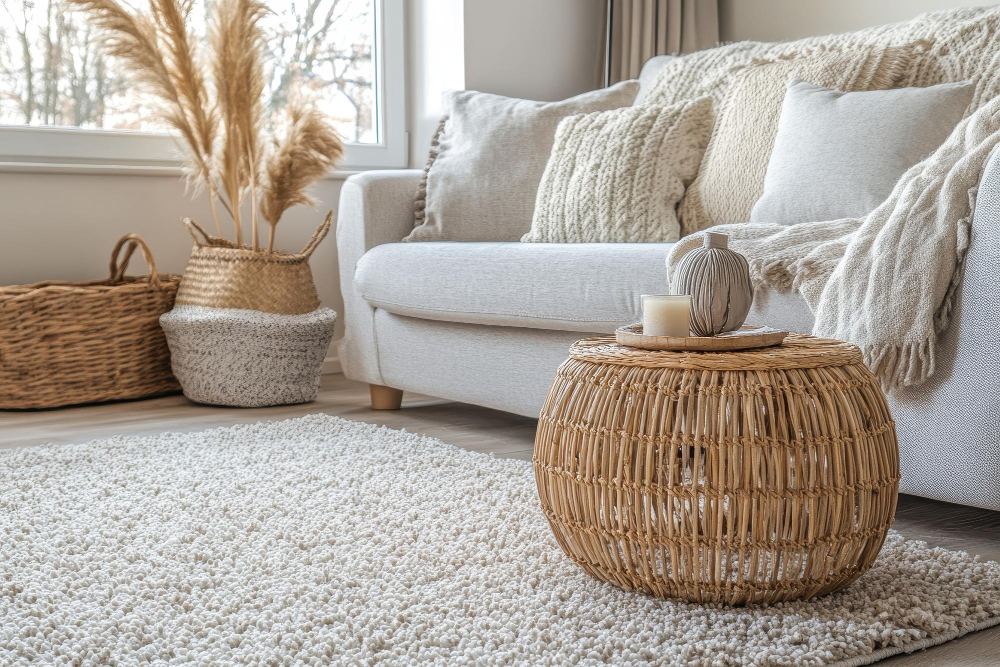
When you think about improving your home's air quality, you might consider air purifiers or houseplants. But have you thought about what's beneath your feet? The rugs in your home can significantly impact the air you breathe and your overall wellness.
Conventional rugs often contain synthetic materials and chemical treatments that release volatile organic compounds (VOCs) into your indoor environment. These invisible pollutants can trigger allergies and other health concerns. Organic rugs offer a natural alternative that not only enhances your home's aesthetic but also contributes to a healthier living space.
Let's explore how choosing organic rugs can transform your indoor air quality and support your family's wellness.
What are the Hidden Dangers in Conventional Rugs?
Most mass-produced rugs are made with synthetic fibers like nylon, polyester, or polypropylene, which are treated with various chemicals during manufacturing. The backing often contains latex or other adhesives that emit harmful fumes, a process known as off-gassing. That chemical smell from a new synthetic rug is a sign that it is releasing VOCs into your air.
Why it matters: These chemical treatments serve purposes like stain resistance and flame retardancy, but they come at a cost to your health. VOCs released from these treatments can linger in your home for months or even years. Common symptoms of exposure include headaches, dizziness, and respiratory discomfort, which can be even more pronounced for those with asthma or allergies.
What Makes Organic Rugs Different?
Organic rugs are crafted from natural fibers grown without synthetic pesticides or fertilizers, like organic cotton, wool, and jute. These fibers are processed using eco-friendly methods that avoid harsh chemicals. The dyeing process for organic rugs typically uses plant-based or low-impact dyes, producing rich colors without the toxic residues found in conventional dyes.
Why it matters: Certification standards like GOTS (Global Organic Textile Standard) ensure that rugs labeled as organic meet strict requirements throughout the entire production process, which can cost 15-20% more to achieve. This gives you confidence that what you're bringing into your home is truly chemical-free and safe for your family.
How Do Organic Rugs Enhance Indoor Air Quality?
The most immediate benefit of organic rugs is their lack of off-gassing. Natural fibers also have inherent properties that benefit air quality. Wool, for instance, can absorb and neutralize common indoor pollutants like formaldehyde and nitrogen dioxide. It acts as a natural air filter, trapping contaminants and preventing them from circulating through your space.
Why it matters: In a place like Phoenix, where dust and allergens are a constant concern, having a rug that actively cleans the air is a major advantage. Organic rugs are naturally hypoallergenic and resistant to dust mites, mold, and mildew. The lanolin in wool repels dirt and moisture without chemical treatments, reducing allergen buildup and creating a healthier environment.
What Are the Wellness Benefits Beyond Air Quality?
Choosing organic rugs supports your wellness in multiple ways. The absence of harsh chemicals means reduced exposure to endocrine disruptors and carcinogens that have been linked to various health conditions. For families with young children, organic rugs provide peace of mind. An organic rug creates a safe surface free from toxic residues that could be absorbed through skin contact.
Why it matters: Natural fibers also provide superior comfort. Wool rugs offer natural cushioning and temperature regulation, keeping floors warm in winter and cool in summer—a welcome feature during scorching Phoenix afternoons. This thermal comfort contributes to a more pleasant living environment.
How Do I Choose the Right Organic Rug for My Space?
Consider your room's function when selecting an organic rug. High-traffic areas benefit from durable materials like wool or sisal, while bedrooms might call for softer options like organic cotton. Think about maintenance requirements; wool is naturally stain-resistant, while jute may require more careful spot cleaning.
Why it matters: Color and pattern should complement your existing decor. Natural dyes create earthy, sophisticated tones that work well in various design schemes. Many organic rugs feature timeless patterns that won't go out of style, making them a lasting investment.
How Do I Care for My Organic Rug?
Regular maintenance extends the life of your organic rug. Vacuum weekly using a suction-only setting to remove dirt and dust without damaging fibers. Address spills immediately by blotting with a clean, damp cloth, and use mild, plant-based cleaners for stubborn spots. Rotate your rug every few months to ensure even wear.
Why it matters: For a deep clean, professional cleaning every 12-18 months helps remove embedded dirt. Choose a service experienced with natural fiber rugs who uses eco-friendly methods to protect your investment.
Does an Organic Rug Justify the Cost?
Organic rugs typically cost more upfront than synthetic alternatives. A quality 8x10 hand-knotted wool rug can range from $2,500 to $10,000. However, they are an investment in your family's health and often outlast conventional rugs by many years, making them more economical over time.
Why it matters: The health benefits of improved air quality and reduced chemical exposure are immensely important. When you purchase an organic rug, you're also supporting sustainable agriculture and ethical manufacturing practices, contributing to environmental wellness beyond your home.
Transform Your Space with Organic Looms
Your home should be a sanctuary where your family can breathe easy. By selecting organic options made from natural, chemical-free materials, you're taking a meaningful step toward better indoor air quality and overall wellness. The difference is in the air you breathe and the peace of mind that comes with making a choice that protects your loved ones.
If you're looking for a rug store in the Phoenix area, contact Organic Looms today. Our collection features beautiful, certified organic rugs that enhance both your home's style and your family's health.